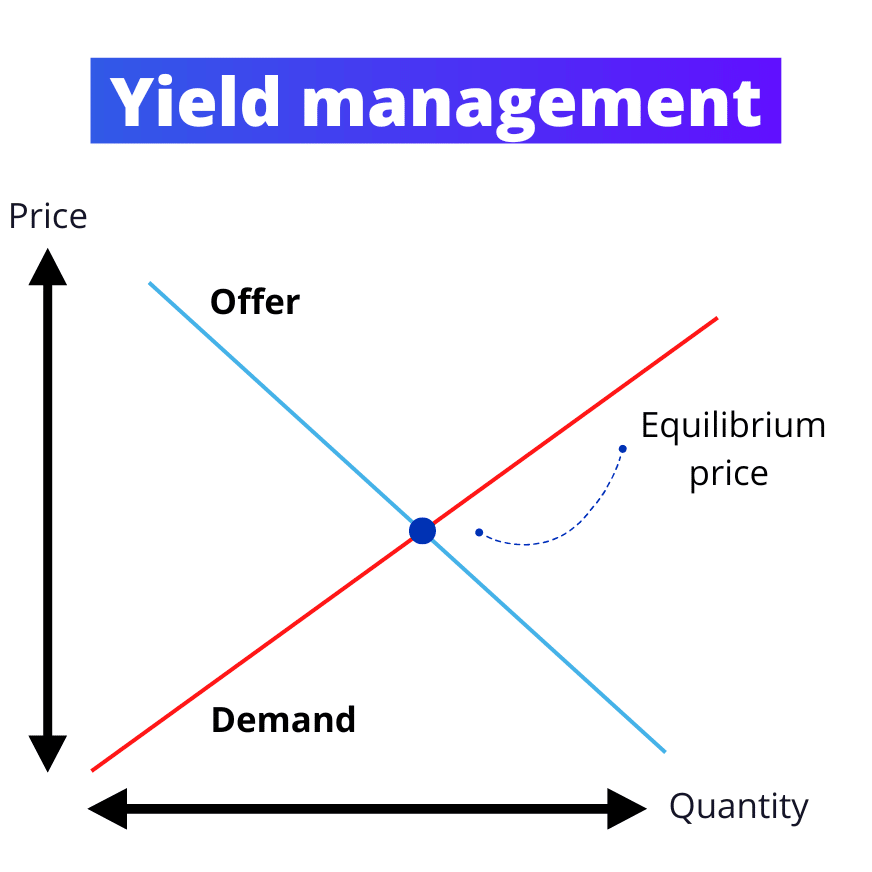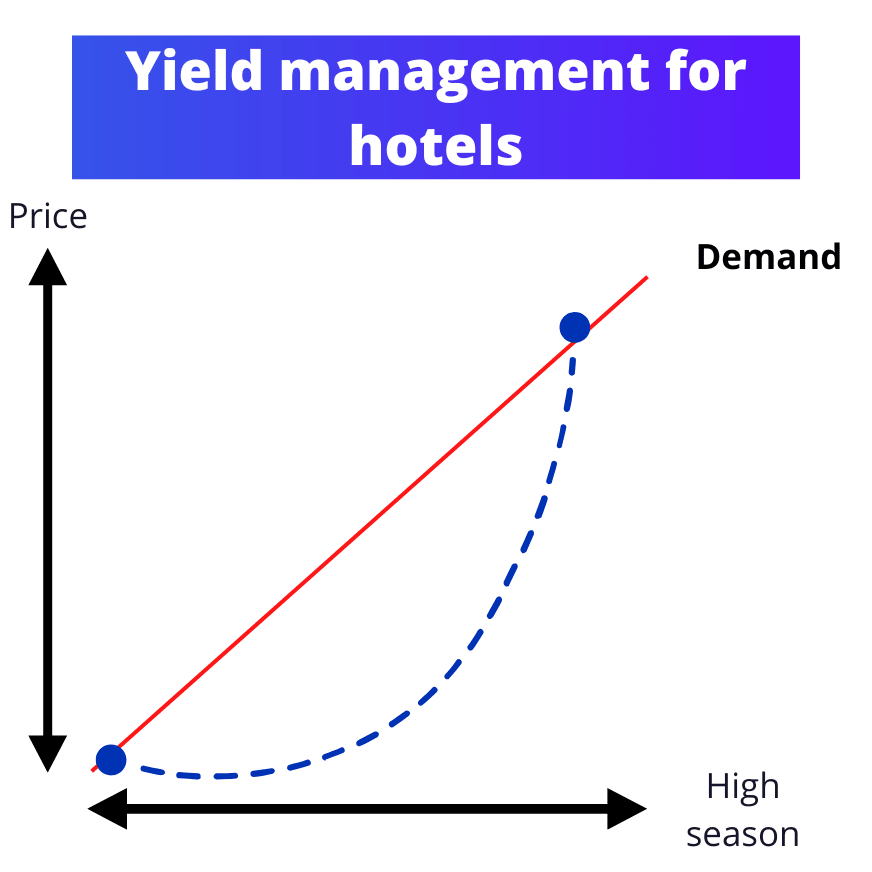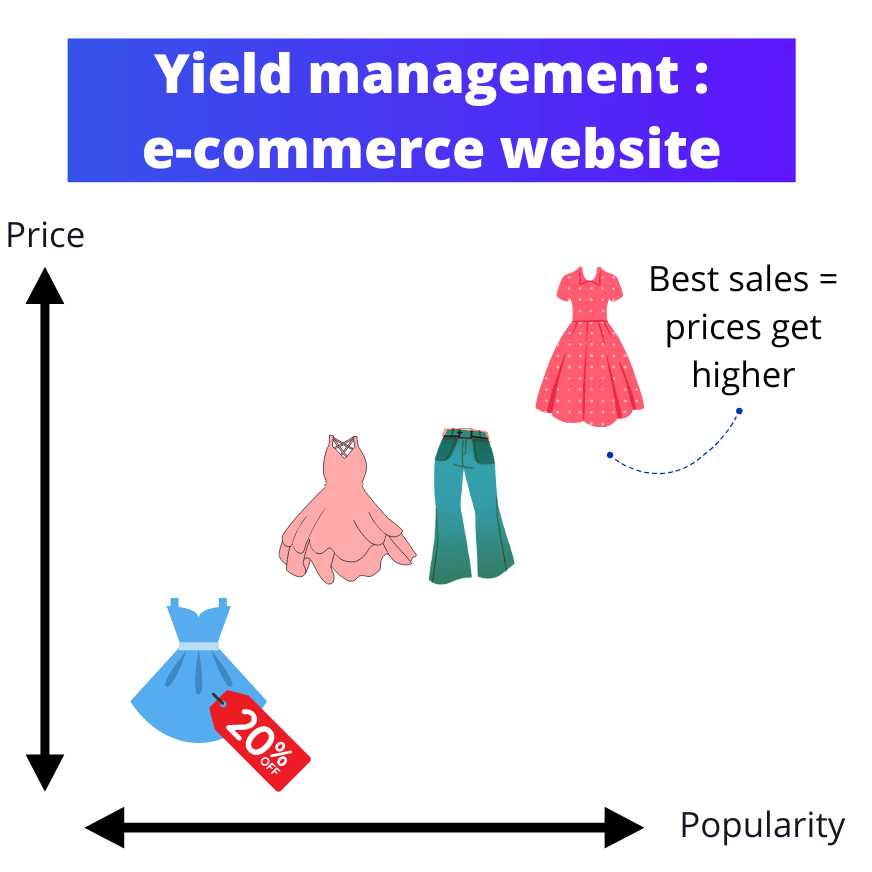What is Yield Management? How to implement it in your business? It is commonly used in the hotel, transportation and leisure industries.
However, this yield management technique is increasingly used in other sectors. It consists of modifying prices according to the actions of consumers.
We explain how 😉
Introduction to Yield Management
🎯 Yield Management is a pricing strategy that involves maximizing revenue by setting dynamic prices for goods and services based on supply and demand, market conditions and other factors. It is a growth marketing technique.
It is often used in industries where demand is variable, such as hospitality, transportation and ticketing. In these sectors, yield management can help companies optimize their pricing to generate the most revenue.
👨🏫 The concept of yield management originated in the airline industry in the 1980s, where it was used to fill empty seats on planes by offering last-minute discounts.
Today, yield management is used in a wide range of industries and has evolved to include various techniques and tools, such as computer algorithms, demand forecasting, and customer segmentation.
Customer segmentation is another important element of yield management, which allows for the customization of prices based on customers’ willingness to pay. 😉
Yield management definition
- Yield management = yield management.
The English term yield refers to the sales margin , i.e., the difference between the selling price and the acquisition cost .
Generally speaking (except for certain luxury products), when prices increase, the number of potential buyers decreases . The more expensive a product or service is , the fewer customers will buy it. But of course, it is not a question of lowering the prices as much as possible. Otherwise, you will lose all your commercial margin, and even more, you risk not making any more profit. So the goal is to find the right price.

There are two types of Yield Management: bottom-up and dynamic. 👇
Bottom-up Yield Management
The goal is to create buyer anticipation: The earlier you book, the more you benefit from reduced prices. This is the opposite of last-minute offers.
That is to say, the consumer knows that he will get the best offer if he books in advance: this is often the case for airline tickets, hotels, or trains for example.
This model does not really fit the buyers in the sense that the sellers have already estimated the price increase in advance without taking into account the increase in demand over time. It is more about predictions.
Dynamic yield management
This model adapts to consumer demand. That is to say that prices will increase by a certain percentage as soon as there are more visits to a site or a particular product.
🛬 For airlines and comparators: For example when a destination becomes more and more visited on air ticket sales sites, this destination increases while other less visited ones decrease.
🌞 For seasonal sales sites: We can imagine the same thing on an e-commerce site, seasonal products like sun creams and swimwear become more expensive during the summer season than all the rest of the year.
🔑 Revenue management is a key part of yield management and involves understanding the demand for a product or service and pricing accordingly.
Examples of Yield management
Yield management allows for real-time pricing that is directly focused on the market. It is possible to imagine several examples of this type of price management.
Yield management in the hotel industry
Yield management is widely used in the hotel industry. It allows for price flexibility and increased profitability. Generally, prices differ according to the season. Hoteliers can use yield management to optimize their pricing policy by adjusting prices according to demand and occupancy rates.

Yield management on a travel website
On travel websites, there can be several marketing strategies based on yield management:
- Depending on the number of visitors to a destination over a given period.
- Depending on the number of visits from the same IP address.
That is, some sites record the IP address with which a user makes a search, and if he continues to search several times for deals on the same destination at the same time period, the comparison site can increase its prices on the deals: it knows that the person searching for this flight is really decided to go.
The other technique consists, like hotels, of varying the prices when there is a peak in searches.

Yield management on an e-commerce site
Have you ever seen certain products increase in price in certain cases? Chocolates become more expensive at Christmas, swimsuits increase in summer, some fruits are more expensive when they are out of season… Pricing strategies keep changing and follow market trends.
Here is a case study example: Yield management in an online clothing store. 💻
👗 Jane owns an online clothing store specializing in vintage and retro-inspired clothing. The business is stable, but Jane is looking for ways to increase her revenue and optimize her prices. She decides to implement that strategy on her online store.
💻 Jane starts by analyzing past sales data and market trends to forecast demand for her products. She also segments her customers based on factors such as location, age, and purchase history to better understand their preferences and willingness to pay.
With this information, Jane begins to dynamically price her products based on demand and market conditions. During busy periods, such as the holiday season, she raises the prices of her most popular items to increase her revenue. During slower periods, she lowers prices on certain items to encourage sales and clear excess inventory.

Jane also uses yield management to offer customized pricing to specific groups of customers. For example, she may offer a discount to customers in a particular region if the cost of living is lower there. She also uses bundling and cross-selling techniques to encourage customers to purchase additional items and increase the average order value.
Overall, yield management has helped Jane increase revenue and optimize pricing in her online clothing store. By analyzing data, segmenting customers, and setting dynamic prices, she is able to maximize her revenue and offer competitive and fair prices to her customers. 🥰
What are the advantages and disadvantages of Yield management?
4 Advantages of a good price management
- 1) Increased revenue 💰: One of the main benefits is that it can help businesses increase their revenue by setting optimized prices based on demand and market conditions. By adjusting prices according to demand, companies can increase revenue and make the most of their capacity.
- 2) Improved pricing strategy 💹 It can help companies develop a more effective pricing strategy by allowing them to set dynamic prices tailored to specific customers and market conditions. This can help companies avoid overcharging or undercharging, which can lead to lost revenue.
- 3) Increased competitiveness 😎: By using that strategy to optimize prices, companies can stay competitive in their market by offering competitive and fair prices. This can help companies attract and retain customers and increase their market share.
- 4) Greater efficiency 💃: Yield management can help businesses make more informed pricing decisions by using data-driven techniques and tools, such as computer algorithms and demand forecasting. This can help companies optimize pricing and reduce the time and effort required to set prices manually.
4 Potential disadvantages
- 1) Customer dissatisfaction 😡: A potential downside is that it can lead to customer dissatisfaction if prices are perceived to be too high or fluctuate too frequently. Customers may feel that they are being overcharged or that prices are unpredictable, which can lead to frustration and loss of loyalty.
- 2) Complexity 😰: implementing Yield management can be complex, as it involves analyzing data, forecasting demand and segmenting customers to set dynamic prices. This can require a significant investment of time and resources and can be difficult for companies with limited resources or expertise.
- 3) Limited flexibility 😬: It typically involves setting prices based on demand and other factors, which can limit companies’ flexibility to offer discounts or promotions. This can make it more difficult for businesses to respond to changing market conditions or customer needs.
- 4) Legal and ethical considerations 😓: This marketing strategy can be perceived as discriminatory or unfair. For example, setting higher prices for certain customer groups based on factors such as location or willingness to pay may be considered discriminatory or unethical. Companies must ensure that their pricing practices are fair and transparent to avoid legal and ethical issues.
Faq of the article
Do I need to use management software?
Using management software for yield management in the hospitality industry can be extremely beneficial for hoteliers. 🥰 A management system can help streamline various processes and make it easier for hoteliers to manage their properties. 👍
One of the key features of management software is a booking engine, which allows hoteliers to manage online travel bookings and reservations. This can be especially useful for hotels that rely on global distribution channels for bookings.
A management system can also help with channel management, allowing hoteliers to manage their distribution channels and optimize their bookings. This can be especially useful for revenue managers, who are responsible for maximizing a hotel’s revenue.
In addition to helping with bookings and distribution, management software can also assist with hotel revenue management. A revenue manager can use the software to analyze data and make informed decisions about pricing and availability in order to maximize profitability.
A management system can also include a channel manager, which allows hoteliers to manage multiple distribution channels from a single platform. This can be especially useful for hotels that use multiple property management systems or that have a central reservation system.
In addition to these features, management software can also include a property management system, which allows hoteliers to manage various aspects of their property, such as guest check-ins and room assignments.
Overall, using management software can be an extremely effective way for hoteliers to manage their properties and maximize profitability. These solutions are often intuitive and can streamline various processes, making it easier for hoteliers to focus on other aspects of their business. 🤑
Which sectors are concerned by that type of prices?
Yield management is a pricing strategy used in many industries, including the hotel, airline, and hospitality industries, to maximize profits by adjusting prices according to demand and market conditions.
Hoteliers can use yield management to optimize their pricing policy by segmenting their customers into different segments based on their willingness to pay and adjust prices accordingly.
Yield management can also be used to anticipate changes in demand and adjust prices accordingly, allowing hoteliers to reduce the risk of overbooking or underbooking, which can result in lost revenue.
Is yield management useful against the competition?
In a competitive environment, yield management can be an effective pricing strategy by offering fair and competitive prices while maintaining customer loyalty.
Hotel managers can use various pricing levers, such as demand elasticity, rate positioning, and product differentiation, to align their pricing policies with business objectives and maximize profits.
Competitive intelligence is also important in yield management, as it allows hoteliers to monitor their competitors ‘ pricing and ensure that they are aligned with the market.
Conclusion
Yield management is a pricing strategy that aims to maximize profits by setting dynamic prices for goods and services based on supply and demand, market conditions and other factors. 🤑
For example, a hotel may charge higher room rates during peak seasons when demand is high and lower rates during quieter periods. Similarly, a company may offer discounts during off-peak periods or when there are unsold seats. By adjusting prices to match demand, companies can maximize revenue and fill capacity. 💹
And there you have it, you know all about Yield management. 🥳













